Vintage decoration is not simply filling a house with old furniture; it is a way to travel back in time without leaving your home. It is about rescuing pieces with soul, giving them a new context and combining them with current elements to create spaces full of personality and warmth.
This style connects with nostalgia, but also with a sustainable and conscious vision of interior design. Instead of consuming compulsively, vintage invites us to stop, value what already exists and rescue stories that are told through objects.
Table of Contents
- Origin and History of Vintage Style
- Defining Features of Vintage Style
- Furniture, Lighting and Accessories
- Practical ideas for every space
- Living room: anchor with a protagonist piece and mix with contemporary touches.
- Kitchen: details with history, but functional
- Bedroom: layers of textiles and pieces that evoke memories.
- Bathroom: tiles or accessories that take us back to another era.
- Small apartments: choose pieces that add character without being overloaded
- Restoration, Purchase and Conservation
- Variations and Fusions. How to play with other aesthetics
- Common Mistakes and How to Avoid Them
Get ready to discover how to capture the magic of the past and bring it to the present in an elegant, balanced and, above all, very personal way.
Origin and History of Vintage Style
Vintage decoration has deep roots that go far beyond a simple aesthetic fashion. Its history is linked both to the evolution of artistic styles and to the cultural and social changes of the 20th century. From the sophisticated furniture of Art Deco to the functional simplicity of mid-century to the explosion of color and shapes of the 1970s, each era has left its mark on what we call vintage today.
Moreover, this style is closely related to the culture of collecting and salvaging. It was not born from mass production, but from the need to preserve the valuable, to find beauty in what time has worn away and to give a second chance to pieces that, far from being discarded, take center stage.
Where does the idea of “vintage” come from?
The word “vintage” comes from the wine industry. Originally, it was used to talk about wines from exceptional vintages, those that acquired more value and prestige over time. Over the years, this term jumped from the world of wine to the world of fashion and decoration to refer to objects, furniture or garments that, despite their age, maintained quality, beauty and authenticity.
The interesting thing about the concept is that not everything old is vintage. To be vintage, a piece needs to have an aesthetic or historical value that transcends the simple passage of time. A worn piece of furniture can be trash if it lacks design, but if it belongs to a recognized trend or reflects the essence of an era, then it acquires that vintage aura.
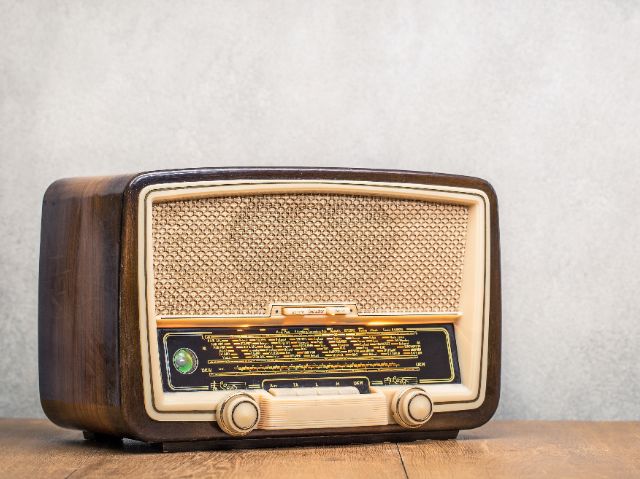
The main eras that nurture this style are various and very different from each other: the Art Deco of the 20s and 30s, with its geometric lines and luxurious materials; the mid-century modern of the 50s and 60s, with its clean and functional design; the 70s, with its warm palette and bold textures; and even certain echoes of the 80s with retro objects that are back in fashion today.
Thus, vintage is more a journey through time than a unique style. It is the sum of several decades, of cultural movements and of a spirit that values the authentic over the disposable.
How it evolved until today: from antique dealers to second-hand stores and re-editions.
In the beginning, vintage was reserved almost exclusively for antique dealers and collectors. They were the ones who knew how to appreciate the rarity of an Art Deco chest of drawers or a velvet upholstered armchair from the 1940s. Over time, this elitist vision changed, and the rise of flea markets and second-hand stores opened the doors so that anyone could have access to pieces with history.
During the 1990s and 2000s, retro fashion and responsible consumption further boosted the revaluation of antique objects. It was not only about decorating beautifully, but also about reducing, reusing and recycling, in a context where society was beginning to question mass production and the environmental impact of fast furniture.
Today, vintage has evolved to the point that many brands produce re-editions of iconic pieces. Thus, a mid-century designer sofa can be found in an antique shop as well as in a newly manufactured catalog. This shows that vintage is not static, but a living concept that adapts to current demand without losing its essence: valuing quality, timeless design and the memory that objects hold.
More than a fashion, vintage is an aesthetic and cultural philosophy that continues to gain strength, and its history is still being written.
Defining Features of Vintage Style
Before jumping into decorating, it is important to recognize what elements make a space feel truly vintage and not simply old or cluttered. This style does not depend on accumulating antique pieces without criteria, but on judiciously choosing furniture, colors and materials that convey the magic of the past.
Key features that define vintage include the patina and authenticity of objects, the strategic use of color and the importance of textures. Each of these elements brings character, warmth and a sense of history that distinguishes this style from other decorative approaches.
Pieces with patina: how to recognize quality and character
One of the great charms of vintage is patina: that mark that time leaves on materials and that speaks of their authenticity. The patina is not a defect, but an added value that differentiates a genuine piece from a simple imitation.
For example, an oak table with subtle marks of use, a slightly oxidized brass knob or a chest of drawers with a worn varnish can have much more charm than a piece of furniture fresh from the factory. These imperfections tell a story and convey the idea that the object has had a life before it came into our hands.
Recognizing quality means paying attention to details:
- Solid woods instead of chipboard.
- Strong joints made with traditional techniques (such as dowels and dovetails).
- Original hardware in brass, bronze or wrought iron.
- Upholstery with character, made from quality materials such as linen, velvet or leather, which show their texture and age gracefully.
The important thing is not to confuse patina with deterioration. A piece may be worn but still functional and beautiful, while a badly damaged one may be more of a nuisance than an asset. The key is to know how to recognize what deserves to be kept as is and what should be restored to give it a second life.
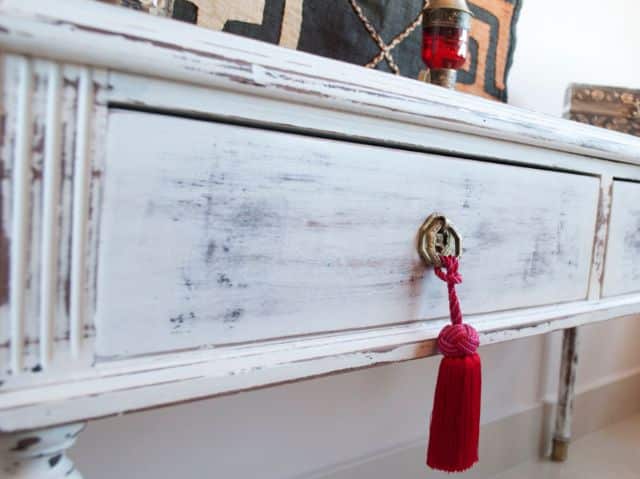
Palettes that give up the limelight (and when to dare with color)
Color in vintage decoration is a key resource to transport us to different eras. Unlike other styles that are based on uniformity, vintage plays with the contrast between neutral tones and vibrant accents that evoke specific decades. The key is to find the balance between a harmonious base and details that bring life and character.
Warm, neutral palettes tend to be the most common base: aged whites, sand tones, soft grays, beige and natural browns. These colors allow the main pieces (a mustard armchair, a forest green sideboard, a turquoise lamp) to shine without saturating the environment.
Depending on the season, certain tones take on greater prominence:
- 1950s-60s (mid-century modern): mustard, olive green, turquoise, burnt orange.
- 70s: intense browns, burgundy, ochre, earth tones and psychedelic patterns.
- Art Deco (20s-30s): contrasts of black, gold, white, with navy blue or emerald accents.
Daring with color means knowing where to place it. A wall painted in a deep hue can become the perfect backdrop for a piece of period furniture. The same goes for textiles: cushions, rugs or curtains in intense tones can completely renovate a space without overloading it.
In short, color in vintage is not a superficial accessory, but a vehicle to evoke past atmospheres. Used intelligently, it transforms the old into the sophisticated and the nostalgic into the present.
Textures and superimpositions: tapestries, velvets, ceramics and worked wood.
Vintage style is enjoyed not only with the eye, but also with the touch. Textures are essential because they add depth, visual richness and a sense of warmth that makes spaces feel cozy. Unlike minimalist interiors, which tend to be flat and uniform, vintage is characterized by layering and layering of materials.
Textiles are the undisputed protagonists:
- Velvet: a sophisticated classic, with a soft texture and intense tones.
- Linen and thick cotton: ideal for bed linen or curtains.
- Crochet and lace: delicate details reminiscent of French vintage or shabby-chic.
Worked wood also plays an essential role, whether carved, turned or simply with prominent natural grains. Similarly, glazed ceramics and blown glass bring a handcrafted touch that connects with the past.
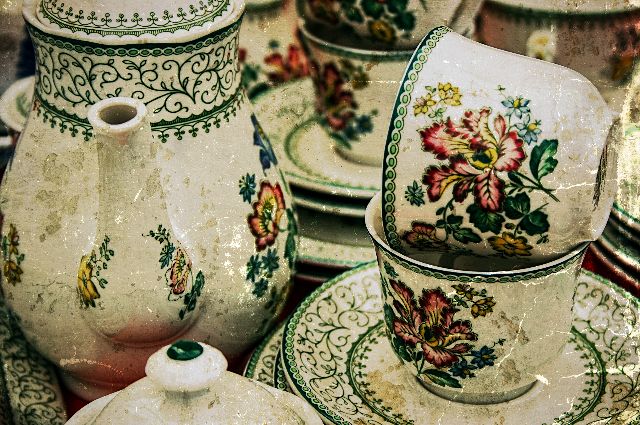
The secret is in the combination: a velvet upholstered sofa with embroidered cushions, a dark wood table with handmade ceramics on top, thick curtains that fall on neutral walls. Everything adds up, but without falling into excess.
The golden rule is that each texture tells a story and complements the others. Thus, the environment is not overloaded, but full of nuances that are discovered little by little.
Furniture, Lighting and Accessories
If color and textures set the atmosphere, furniture and accessories are the true protagonists of vintage style. It is not a matter of filling the house with random antique pieces, but of selecting objects with character and knowing how to balance them with contemporary elements.
Vintage has the virtue of allowing us to coexist with the past without being trapped in it. A single well-chosen piece can transform a space, but too many give the feeling of being in a museum or a flea market. Therefore, furniture, lighting and decorative objects should be chosen consciously.
In this section, we will look at how to choose iconic furniture, what role lighting plays and how to organize collections without overcrowding.
Iconic furniture by era (how to use it without saturating)
Each era has left traces in furniture design that today we recognize as icons of vintage style. Incorporating one of these pieces in a contemporary environment can be enough to evoke an entire decade.
Some examples:
- Art Deco (1920s-30s): chests of drawers with glossy lacquers, geometric mirrors, armchairs with curved shapes.
- Mid-century modern (50s-60s): light wood sideboards, chairs with tapered legs, straight-lined sofas.
- 70s: low coffee tables, velvet upholstered armchairs, modular furniture.
The key is to use these pieces as visual anchors. For example, a modern living room with a contemporary sofa can be enriched with a mid-century armchair and an Art Deco coffee table. In this way, the antique furniture does not compete, but rather stands out thanks to the contrast with the contemporary.
A common mistake is to saturate the space with too much period furniture, which ends up giving the feeling of a themed showcase. The trick is to think in balance: a vintage piece as a protagonist accompanied by current neutral furniture creates an elegant and sophisticated result.
Lighting: lamps as collector’s items
Vintage-style lamps are not just a source of light: they are true decorative gems. From floor lamps with textured shades to crystal chandeliers or brass pendant lights, each can function as a collector’s item that elevates the mood.
Table lamps with hand-painted ceramic bases or blown glass ceiling lights are examples of pieces that add character. In addition, vintage lighting benefits from combining layers of light:
- Ambient light: general and warm, ideal for providing comfort.
- Focal light: floor or desk lamps that create intimate corners.
- Decorative light: small points of light that highlight objects or textures.
Integrating these layers allows the decoration to be lived in an enveloping way, highlighting materials and creating a cozy atmosphere. A good lamp can become the heart of a room, both for its aesthetics and the warmth it brings.
Recommended products

In Stock, estimated delivery from 20-30 days
12.69 £
Fermaluce Vintage LED Surface Lamp Creative-Cables KPL27PRADE2
View product

In Stock, delivery in 16-21 days
21.19 £
Jigger Wall Lamp
View product

In Stock, delivery in 24/48h
122.99 £
Crystal Pendant Lamp Kurta
View product

In Stock, delivery in 16-21 days
44.99 £
Bedourie Wall Lamp
View product
Art, objects and collections: judicious selection versus accumulation.
One of the most common mistakes when decorating in vintage style is to confuse curation (an intentional and harmonious selection of pieces) with accumulation. Having a lot of antique pieces does not guarantee an elegant space; in fact, it can generate the opposite effect: a chaotic environment that is more reminiscent of a messy flea market than a home with personality.
The key is to select and not simply collect. Each object should have a purpose: to tell a story, add character or reinforce the aesthetic palette of the room. This doesn’t mean you should limit yourself to one piece per space, but rather that the important thing is consistency among the elements.
Some practical guidelines to achieve this are:
- Choose meaningful pieces: a baroque mirror, a pendulum clock, a retro painting or porcelain tableware.
- Avoid visual saturation: leaving empty spaces allows vintage to breathe and shine.
- Highlight the special: present your collections (old cameras, vinyl, bottles, etc.) in a careful and deliberate way, never improvised.
- Mix with the current: a contemporary bookshelf can be the perfect support for displaying vintage items without making the space look dated.
In short, decorating with vintage objects does not mean turning the house into a museum, but a place where each piece brings its own touch without competing with the others.
Practical ideas for every space
The vintage style can be applied in any corner of the home, as long as it adapts to the needs of each space. It is not the same to decorate a large living room as a small bathroom, nor should the same resources be used in a functional kitchen as in a cozy bedroom.
The key is to strategically choose which pieces and details to use in each environment, always maintaining a balance between the old and the new. Next, we will see how to apply the vintage aesthetic in different rooms of the house with practical examples.
Living room: anchor with a protagonist piece and mix with contemporary touches.
The living room is undoubtedly the ideal space to experiment with vintage style, as it is usually the largest and most social area of the house. Here, a single statement piece can completely transform the atmosphere.
Examples of visual anchors in a living room:
- A mid-century armchair upholstered in emerald green velvet.
- An Art Deco coffee table with metallic accents.
- A Persian rug that adds color and texture.
The best strategy is to combine these pieces with contemporary elements with simple lines, such as a modern sofa in neutral tones or minimalist bookshelves. In this way, vintage stands out without making the space feel overloaded.
Art also plays a key role: a retro painting, an original poster from the 1970s or black and white photographs can serve as visual touches that reinforce the narrative.
Ultimately, the vintage living room should feel warm, welcoming and full of character, but never excessive. It’s all about balancing the charm of the past with the comfort of the present.
Kitchen: details with history, but functional
In the kitchen, vintage can be expressed more subtly, as it is a space where functionality rules. However, small decorative details can make this area have a nostalgic air and full of personality.
Some practical ideas:
- Antique handles and hardware on kitchen cabinets.
- Retro tiles with geometric patterns or bright colors.
- Classic pendant lamps, such as blown glass or enameled metal.
- Functional vintage accessories, such as glass jars, metal cans or antique utensils on display.
While modern appliances are a must, you can choose discreet finishes or even models with retro aesthetics, so popular today.
The secret, as always, is not to overload. A couple of well-chosen details are enough to give an air of another era without compromising the practicality of a contemporary kitchen.
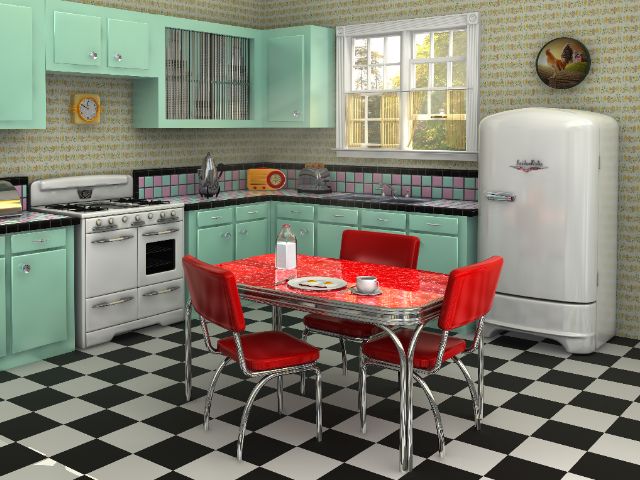
Bedroom: layers of textiles and pieces that evoke memories.
The vintage bedroom invites rest through the warmth of textiles and the presence of pieces with history. Here, more than in other spaces, the layering of fabrics plays a crucial role. Wool blankets, embroidered bedspreads, textured cushions and heavy curtains transform the space into a cozy haven.
Among the most iconic elements are:
- Antique carved wood or wrought iron headboards.
- Restored bedside tables that retain their patina.
- Vintage linens, from washed linen to delicate lace.
Including familiar objects adds sentimental value that enriches the décor. For example, a lamp inherited from grandparents or an antique mirror can become protagonists.
In this space it is important not to fall into excess. It is enough to integrate two or three key vintage elements and let them coexist with modern furniture to achieve a balanced and relaxing aesthetic.
Bathroom: tiles or accessories that take us back to another era.
The bathroom is a space where vintage can appear in subtle details that make a difference. Although it is usually a mainly functional place, there are ways to incorporate this retro touch without sacrificing comfort.
Here are some suggestions:
- Pedestal sinks or vintage-inspired furniture.
- Antique faucets in bronze, copper or brushed nickel finishes.
- Subway tiles reminiscent of early 20th century bathrooms.
- Beveled mirrors with ornate frames.
- Ceramic or glass fixtures that add texture and light.
A vintage bathroom can be both elegant and fun, it just depends on the details chosen. The important thing is not to forget that it is still a space for daily use, so the decorative elements must resist humidity and require little maintenance.
Small apartments: choose pieces that add character without being overloaded
In small spaces, decorating in vintage style may seem a challenge, but in reality it is a matter of choosing more accurately. It is advisable to go for 1 or maximum 2 strategic pieces.
Effective examples:
- An Art Deco mirror that expands the sense of space.
- A vintage floor lamp that adds personality and light.
- A restored retro chair as a focal point in a corner.
Storage is key in small apartments, so vintage should be complemented by more practical contemporary furniture. The result is a balance between modern functionality and the charm of the past.
So, even in a small space, it’s possible to capture the magic of this style without making the space look cluttered.
Restoration, Purchase and Conservation
The charm of vintage style lies not only in finding pieces with history, but also in knowing how to take care of them and give them new life. Many times objects come to us worn, incomplete or damaged, and that’s where restoration comes into play. In addition, smart shopping and proper conservation make the difference between an object that lasts and one that deteriorates quickly.
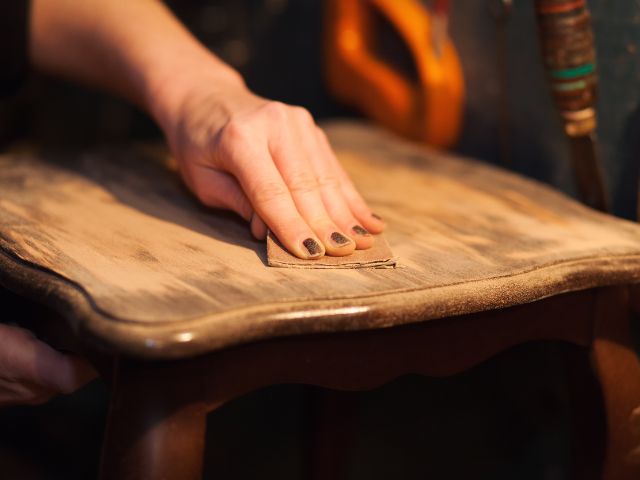
Restoring, reupholstering, customizing: when it pays off
Not all vintage pieces require the same type of intervention. Some shine as they are, with their natural patina, while others need a little help to blend in with today’s décor.
- Restore: Ideal when the piece of furniture has structural damage or very deteriorated finishes. The aim is to restore its functionality without erasing the traces of time. Example: repairing a wooden table with loose legs, but keeping its marks of use.
- Reupholstering: Recommended for sofas and armchairs that have a good structure, but whose fabric is worn. Here you can play with contemporary textiles to give them a new life without losing the retro feel.
- Customize: When you seek to adapt a piece to a personal style. It may involve painting, changing hardware or even transforming the original use. Example: turning an antique trunk into a coffee table.
The key is to evaluate whether these actions add value without detracting from authenticity. In many cases, maintaining the patina is preferable to leaving the object as new, since wear and tear is part of its charm.
Where to buy: antique shops, flea markets, second hand and new vintage
Nowadays, there are many places where you can find vintage pieces, and each one offers different experiences and advantages:
- Antique shops: They guarantee authenticity and usually have pieces of great value, although prices are higher.
- Markets and flea markets: Perfect for those who enjoy “treasure hunting”. They require patience and a critical eye to distinguish between the valuable and the merely old.
- Online second-hand stores: Platforms such as Wallapop, eBay or specialized marketplaces allow access to a wide variety of pieces without leaving home.
- Auctions: Opportunity to get unique pieces, although they require knowledge to bid judiciously.
- New pieces with vintage aesthetics: Many current manufacturers and stores offer furniture and objects inspired by vintage style, which allows to achieve the desired look without sacrificing comfort, warranty or impeccable condition.
In all cases, it is important to look at the condition, authenticity and price. Not everything that looks antique is, and not always what is cheap ends up being a good buy if it requires too much restoration.
Variations and Fusions. How to play with other aesthetics
Vintage style is not rigid, quite the contrary, it lends itself to merging with other styles to create unique and personalized environments. Let’s take a look at some of the most popular fusions.
Vintage + modern (contemporary balance)
Undoubtedly one of the most common options based on integrating vintage pieces as protagonists within a modern base. It works well because the clean lines and neutral colors, enhance the antique objects without looking out of place.
For example, a modern living room in white and gray with a mid-century wooden sideboard in honey tones. A contrast that brings sophistication and balance.
The goal is to maintain a 70-30 ratio, with 30% vintage pieces. Thus, the space maintains a modern look, but with soul and character.
Shabby-chic and French vintage
Shabby-chic is a romantic variant of vintage. Ideal for those seeking a delicate, feminine and cozy atmosphere, it is characterized by:
- Bleached and worn woods.
- Powdered tones (pale pink, sky blue, off-white).
- Lace, flowers and soft textiles.
French vintage, on the other hand, plays with more classic furniture, such as wrought iron headboards and ornate mirrors.
This combination is perfect because the softness of the light tones and delicate textiles balances the elegance of the more classic elements and full of details, creating a harmonious atmosphere.
Mid-century revival vs Retro 70s
Although they are often mixed, they have clear differences:
- Mid-century modern: straight lines, tapered legs, light woods, colors like mustard, olive green and turquoise.
- Retro 70s: curved shapes, warm palette (ochers, browns, oranges), bold textures like velvet and psychedelic patterns.
Both styles are very fashionable and, although they can be combined, it is better to choose one as predominant to avoid visual confusion.
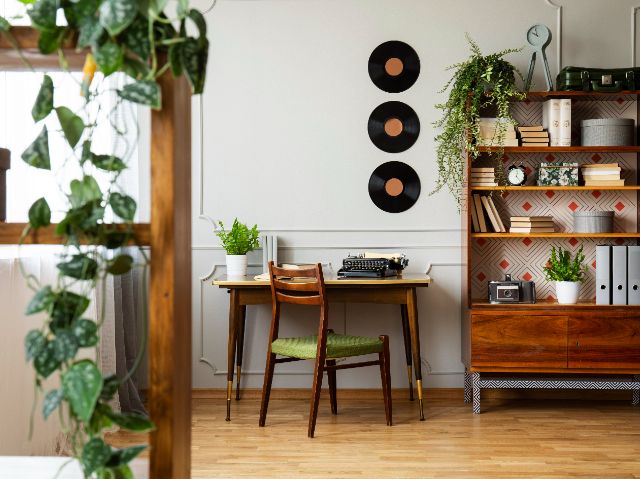
Vintage industrial
The industrial style is inspired by old workshops and factories, adapting its aesthetics to the contemporary home. It is characterized by:
- Exposed brick.
- Iron and steel combined with reclaimed wood.
- Lamps and furniture with metal structures.
This style can be softened with classic vintage accents, achieving a controlled eclecticism that mixes the rough with the sophisticated. The result is urban, authentic and with a lot of personality.
Common Mistakes and How to Avoid Them
Vintage style can be a double-edged sword. When executed with care, it adds elegance and authenticity, but if applied carelessly, it can look improvised or forced.
Mistakes to avoid:
- Excess of pieces or collecting without criteria: accumulating too many objects without cohesion generates chaos and makes the space lose harmony.
- Thematic or period saturation: overuse of a specific decade turns the house into a stage instead of a timeless home.
- Deteriorated or poorly restored furniture: what is broken or in poor condition detracts from elegance and character, so only restore what is necessary.
- Inauthentic or low quality materials: bad modern imitations that seek to look vintage, but do not transmit authenticity and break the coherence of the style.
To get it right, it is advisable to choose a few main pieces and combine them with a neutral base, so that each element stands out without overloading the space. It is advisable to respect the original patina, restoring only what is essential, and to apply color and texture with intention. All of this should be balanced with the functionality of the space, ensuring that it is both practical and aesthetically appealing.
Final keys to vintage style
Decorating with vintage style is much more than a trend: it’s a way to capture the magic of the past and bring it into the present in an elegant and meaningful way. Each piece tells a story, and by integrating them judiciously, we achieve unique spaces that reflect both our personality and our respect for history and sustainability.
The secret is in the balance: it’s not about living in a museum, but about creating a contemporary home with a retro soul. If you know how to choose, restore and combine intelligently, vintage can turn any space into a place full of charm and authenticity.


